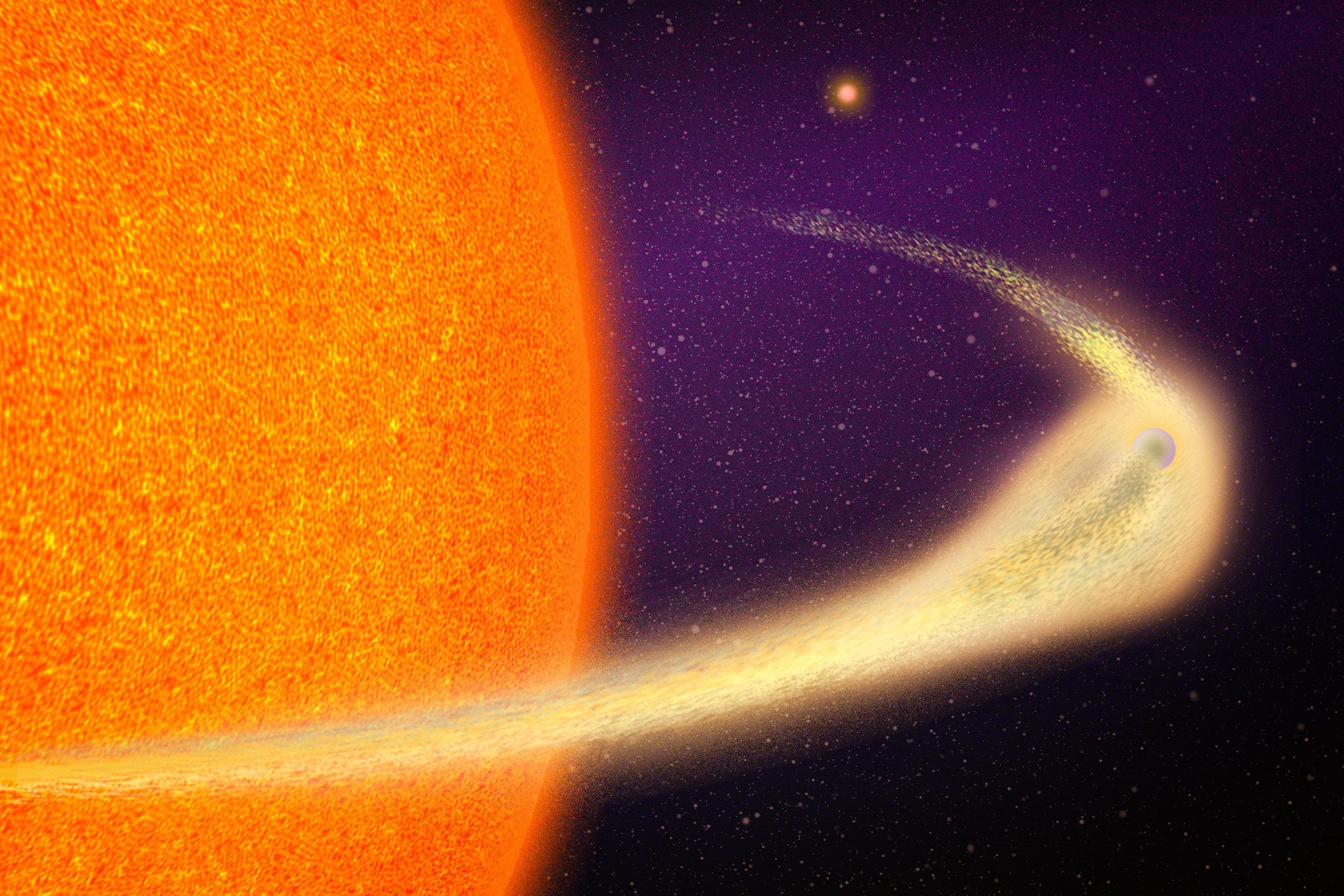Jennifer Chu | MIT News
2025-04-22 10:30:00
news.mit.edu

MIT astronomers have discovered a planet some 140 light-years from Earth that is rapidly crumbling to pieces.
The disintegrating world is about the mass of Mercury, although it circles about 20 times closer to its star than Mercury does to the sun, completing an orbit every 30.5 hours. At such close proximity to its star, the planet is likely covered in magma that is boiling off into space. As the roasting planet whizzes around its star, it is shedding an enormous amount of surface minerals and effectively evaporating away.
The astronomers spotted the planet using NASA’s Transiting Exoplanet Survey Satellite (TESS), an MIT-led mission that monitors the nearest stars for transits, or periodic dips in starlight that could be signs of orbiting exoplanets. The signal that tipped the astronomers off was a peculiar transit, with a dip that fluctuated in depth every orbit.
The scientists confirmed that the signal is of a tightly orbiting rocky planet that is trailing a long, comet-like tail of debris.
“The extent of the tail is gargantuan, stretching up to 9 million kilometers long, or roughly half of the planet’s entire orbit,” says Marc Hon, a postdoc in MIT’s Kavli Institute for Astrophysics and Space Research.
It appears that the planet is disintegrating at a dramatic rate, shedding an amount of material equivalent to one Mount Everest each time it orbits its star. At this pace, given its small mass, the researchers predict that the planet may completely disintegrate in about 1 million to 2 million years.
“We got lucky with catching it exactly when it’s really going away,” says Avi Shporer, a collaborator on the discovery who is also at the TESS Science Office. “It’s like on its last breath.”
Hon and Shporer, along with their colleagues, have published their results today in the Astrophysical Journal Letters. Their MIT co-authors include Saul Rappaport, Andrew Vanderburg, Jeroen Audenaert, William Fong, Jack Haviland, Katharine Hesse, Daniel Muthukrishna, Glen Petitpas, Ellie Schmelzer, Sara Seager, and George Ricker, along with collaborators from multiple other institutions.
Roasting away
The new planet, which scientists have tagged as BD+05 4868 Ab, was detected almost by happenstance.
“We weren’t looking for this kind of planet,” Hon says. “We were doing the typical planet vetting, and I happened to spot this signal that appeared very unusual.”
The typical signal of an orbiting exoplanet looks like a brief dip in a light curve, which repeats regularly, indicating that a compact body such as a planet is briefly passing in front of, and temporarily blocking, the light from its host star.
This typical pattern was unlike what Hon and his colleagues detected from the host star BD+05 4868 A, located in the constellation of Pegasus. Though a transit appeared every 30.5 hours, the brightness took much longer to return to normal, suggesting a long trailing structure still blocking starlight. Even more intriguing, the depth of the dip changed with each orbit, suggesting that whatever was passing in front of the star wasn’t always the same shape or blocking the same amount of light.
“The shape of the transit is typical of a comet with a long tail,” Hon explains. “Except that it’s unlikely that this tail contains volatile gases and ice as expected from a real comet — these would not survive long at such close proximity to the host star. Mineral grains evaporated from the planetary surface, however, can linger long enough to present such a distinctive tail.”
Given its proximity to its star, the team estimates that the planet is roasting at around 1,600 degrees Celsius, or close to 3,000 degrees Fahrenheit. As the star roasts the planet, any minerals on its surface are likely boiling away and escaping into space, where they cool into a long and dusty tail.
The dramatic demise of this planet is a consequence of its low mass, which is between that of Mercury and the moon. More massive terrestrial planets like the Earth have a stronger gravitational pull and therefore can hold onto their atmospheres. For BD+05 4868 Ab, the researchers suspect there is very little gravity to hold the planet together.
“This is a very tiny object, with very weak gravity, so it easily loses a lot of mass, which then further weakens its gravity, so it loses even more mass,” Shporer explains. “It’s a runaway process, and it’s only getting worse and worse for the planet.”
Mineral trail
Of the nearly 6,000 planets that astronomers have discovered to date, scientists know of only three other disintegrating planets beyond our solar system. Each of these crumbling worlds were spotted over 10 years ago using data from NASA’s Kepler Space Telescope. All three planets were spotted with similar comet-like tails. BD+05 4868 Ab has the longest tail and the deepest transits out of the four known disintegrating planets to date.
“That implies that its evaporation is the most catastrophic, and it will disappear much faster than the other planets,” Hon explains.
The planet’s host star is relatively close, and thus brighter than the stars hosting the other three disintegrating planets, making this system ideal for further observations using NASA’s James Webb Space Telescope (JWST), which can help determine the mineral makeup of the dust tail by identifying which colors of infrared light it absorbs.
This summer, Hon and graduate student Nicholas Tusay from Penn State University will lead observations of BD+05 4868 Ab using JWST. “This will be a unique opportunity to directly measure the interior composition of a rocky planet, which may tell us a lot about the diversity and potential habitability of terrestrial planets outside our solar system,” Hon says.
The researchers also will look through TESS data for signs of other disintegrating worlds.
“Sometimes with the food comes the appetite, and we are now trying to initiate the search for exactly these kinds of objects,” Shporer says. “These are weird objects, and the shape of the signal changes over time, which is something that’s difficult for us to find. But it’s something we’re actively working on.”
Upgrade your audio game with the Logitech for Creators Blue Yeti USB Microphone. With over 33,730 ratings and an impressive 4.6 out of 5 stars, it’s no wonder this is an Amazon’s Choice product. Recently, 5K+ units were purchased in the past month.
Available in five stunning colors: Teal, Silver, Pink Dawn, Midnight Blue, and Blackout, this microphone is perfect for creators looking to produce exceptional audio. Priced at only $84.99, it’s a deal you can’t afford to miss.
Elevate your recordings with clear broadcast-quality sound and explore your creativity with enhanced effects, advanced modulation, and HD audio samples. Order now for just $84.99 on Amazon!
Help Power Techcratic’s Future – Scan To Support
If Techcratic’s content and insights have helped you, consider giving back by supporting the platform with crypto. Every contribution makes a difference, whether it’s for high-quality content, server maintenance, or future updates. Techcratic is constantly evolving, and your support helps drive that progress.
As a solo operator who wears all the hats, creating content, managing the tech, and running the site, your support allows me to stay focused on delivering valuable resources. Your support keeps everything running smoothly and enables me to continue creating the content you love. I’m deeply grateful for your support, it truly means the world to me! Thank you!
|
BITCOIN
bc1qlszw7elx2qahjwvaryh0tkgg8y68enw30gpvge Scan the QR code with your crypto wallet app |
|
DOGECOIN
D64GwvvYQxFXYyan3oQCrmWfidf6T3JpBA Scan the QR code with your crypto wallet app |
|
ETHEREUM
0xe9BC980DF3d985730dA827996B43E4A62CCBAA7a Scan the QR code with your crypto wallet app |
Please read the Privacy and Security Disclaimer on how Techcratic handles your support.
Disclaimer: As an Amazon Associate, Techcratic may earn from qualifying purchases.













































![[Download] Intuitive 3D Modeling | Abstract Sculpture | FLIGHT | DANA KRYSTLE](https://techcratic.com/wp-content/uploads/2025/08/1755630966_maxresdefault-360x180.jpg)








































![[DEBUT COVER] Intergalactic Bound – Yunosuke / CircusP [MIKU EXPO 10th]](https://techcratic.com/wp-content/uploads/2025/08/1755598927_maxresdefault-360x180.jpg)


















